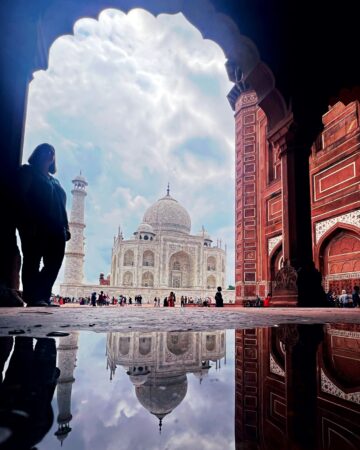
Rachel at the Taj Mahal ©
My job takes me to some remarkable places around the world, most recently to India, a country that that I have not traveled to in years I have always enjoyed my visits to this vast country where every region utilizes its own unique culture and history to create a vibrant, youthful, bustling atmosphere. On this trip I spent most of my time in Delhi with a side trip to Bangalore and just enough time to squeeze in a jaunt to a place I had yet to visit, Agra, to see the iconic Taj Mahal. Taking in the historic significance of this breathtaking monument symbolizing the love of Moghul Emperor, Shah Jahan for his wife Mumtaz Mahal and seeing the crowds dressed in their jeweled vibrant finery to have photos taken in front of this architectural treasure reminded me that India has so many ancient traditions deserving of preservation, not only their monuments but, cultural traditions and heritage.
The distillation of essential oils or attars from locally sourced materials is one such tradition that, of course, I will focus on here. However, instead of concentrating on the materials themselves, mostly produced in Kannuaj, Uttar Pradesh known as the perfume capital of India, here are two small perfume houses from India that have taken very different approaches to maintaining and passing on local perfumery traditions.
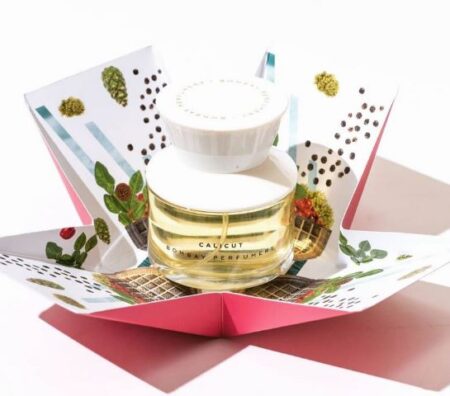
Bombay Perfumery Calicut photo courtesy of the brand (collage by Rachel)
Bombay Perfumery Calicut (2016): Although India supplies natural materials to all the global perfume creation houses, the domestic perfume market is dominated by imported European brands. Bombay Perfumery’s founder, Manan Gandhi, whose family has a long history of exporting essential oils, decided to return to his home in Mumbai (formerly Bombay) after completing his studies in the US and France, to start his own perfume brand in 2016 with the goal of enticing a younger generation looking to embrace local brands and fashions. Bombay Perfumery uses traditional Indian as well as more classic Western ingredients and presents them in a more European fashion (both in character of scent and physical presentation). The fragrances are created by perfumers in Grasse under the creative direction of Mr. Gandhi. His inspiration stems from locales around the world but all of his creations weave subtle hints of India throughout.

Bombay Perfumery Calicut courtesy of the brand
The scent that from this trip to India most called to me was Calicut, a spicy / woody fragrance named after the southern Indian city in Kozhikode. With Bombay Perfumery Calicut your nose is immediately welcomed by a crisp citrusy bergamot and mix of pepper and spices. You could easily mistake this for several high-end brands with its natural yet highly tenacious scent. The cedar smells freshly cut and the vetiver in the base is vibrantly green with a touch of smokiness. Described by the brand as, “an ancient marketplace where flavors of the earth change hands and home, peppered with architectural souvenirs left behind by overwhelmed explorers,” Bombay Perfumery Calicut certainly brings forth images of a crowded spice market with woven vetiver mats hung across doorways and sprinkled with water to provide a cool verdant aroma against India’s summer heat. Bombay Perfumery’s website categorizes this as a masculine scent but, I know many women who would happily wear this elegant spicy green fragrance. Top: Elemi, Bergamot, Cardamom; Heart:Nutmeg, Black Pepper, Cedarwood;Base: Vetiver, Patchouli, Oakmoss, Musk
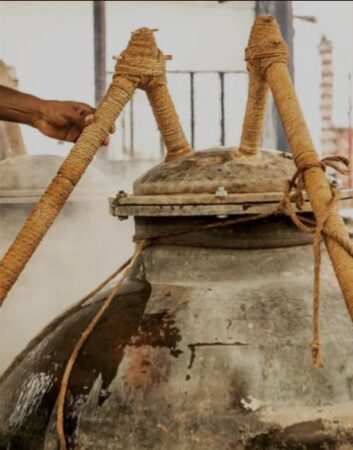
Naso Profumi Distillery courtesy of the brand©
In the same small shop at the Roseate Hotel in Delhi, Naso Profumi caught my attention Only while researching the brand for this post, did I realize that Naso Profumi uses an entirely different method of incorporating local perfumery traditions into their creations. Founded by Astha Suri, Creative Director and Nischal Suri, Perfumer, Naso Profumi utilizes their own in-house distillery based in the Northern Indian city of Lucknow to create artisanal perfumes from all natural essences and the glass bottles are also made locally.
None of this was known when I first smelled these scents and does not change that I was immediately enamored with their highly distinctive blends and intoxicating aromas. The two Naso Profumi fragrances that I chose to take home with me couldn’t be more different from each other:
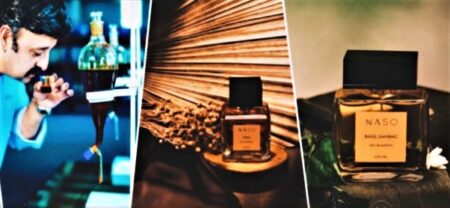
Naso Profumi Nischal Suri Basil Sambac and Naso Profumi Tabac courtesy of the brand
Naso Profumi Basil Sambac (Nischal Suri) utilizes one of the most traditional ingredients in India, Jasmine Sambac, in combination with basil leaf extract to create something completely exceptional. Naso Profumi Basil Sambac starts off with an overdose of jasmine, locally known as mogra or motiya, by using a distillation of sambac oil along with a jasmine attar creating an intoxicatingly heady floral sweetness. Having smelled hundreds of jasmine perfumes and oils over the years, this one is unique. It downplays the indolic nature of jasmine and plays upon the natural sweetness which is then joined with the base of herbal green basil. While not mentioned in the brief list of notes, I also smell clay or damp earth in the dry down, and I feel I can smell of a field of jasmine in the rain. I could not resist purchasing Basil Sambac as a scented souvenir of this trip to India. Top: Mogra Oil; Heart: Natural Jasmine Attar; Base: Basil Leaf Extract
Naso Profumi Tabac (Nischal Suri): It is easy to understand why Naso Profumi Tabac was awarded the Best Fragrance 2022 by Vogue India; it is not a scent that you can easily forget. Lush and dark from the start, this reminds me of fragrances produced by the top Arabian brands who are some of the largest customers of the traditional attars and oils coming out of India. Naso Profumi Tabac claims to use Tobacco Leaf, Tobacco and Tobacco Attar along with oud which explains the richness and density of this scent. The tobacco found here is some of the purest; at times sticky and green and then darkening into something chewy that you can almost taste. Thankfully the vanilla and tonka bean smooth out the roughness without adding any overwhelming sweetness. Naso Profumi Tabac is a true tobacco lover’s fragrance, and an enduring reminder why the knowledge of traditional Indian perfumery, passed from generation to generation yet at risk of being forgotten like so many ancient art forms, should be carefully preserved in the same manner as the physical wonders of the world. I look forward to returning and exploring more of the cultural marvels that India holds. Top: Tobacco Leaf Extract, Sweet Amber Extract; Heart: Tobacco, Vanilla, Oud al ruh; Base: Tonka Bean Extract, Tobacco Attar
Rachel Watson, Senior Contributor
Disclaimer: Review is based on bottles I purchased. My opinions are my own.
Some details about Bombay Perfumery were found in a New York Times article.
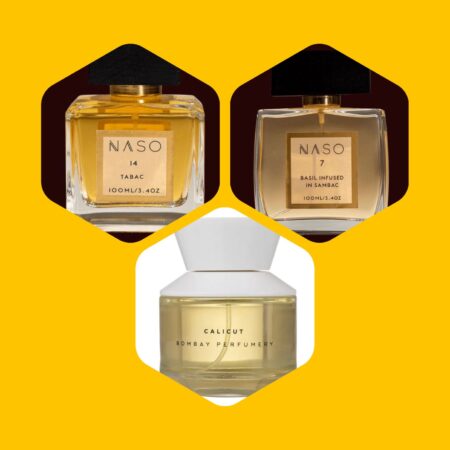
Scents of India: Bombay Perfumery Calicut, Naso Profumi Basil Sambac and Naso Profumi Tabac (collage by Rachel using bottles from the brands)
Thanks to the kindness of Rachel, there is a draw for a sample of one of the three scents of India for one registered reader in the US ONLY. YOU MUST REGISTER. To be eligible, please leave a comment saying which of the three perfumes you would choose based on Rachel’s reviews. Draw closes 10/17/2022
Both Bombay Perfumery and Naso Profumi are sold only to retailers in India but each has a website with worldwide shipping available.
Follow us on Instagram @cafleurebonofficial @dubaiscents @bombayperfumery @nasoprofumi
This is our Privacy and Draw Rules Policy
We announce the winners only on our site and on our Facebook page, so like ÇaFleureBon and use our blog feed… or your dream prize will be just spilled perfume
Like our Facebook page: Çafleurebon and use our blog feed for new updates and articles
